King Faisal Hospital: Cultural Diversity in Surgical Nursing
VerifiedAdded on 2022/10/15
|10
|3453
|4
Report
AI Summary
This report presents a literature review and survey analysis on the impact of cultural diversity in the Surgical Nursing Department of King Faisal Specialist Hospital and Research Center in Riyadh. The review emphasizes the importance of cultural competence for nurses in providing effective patient ...
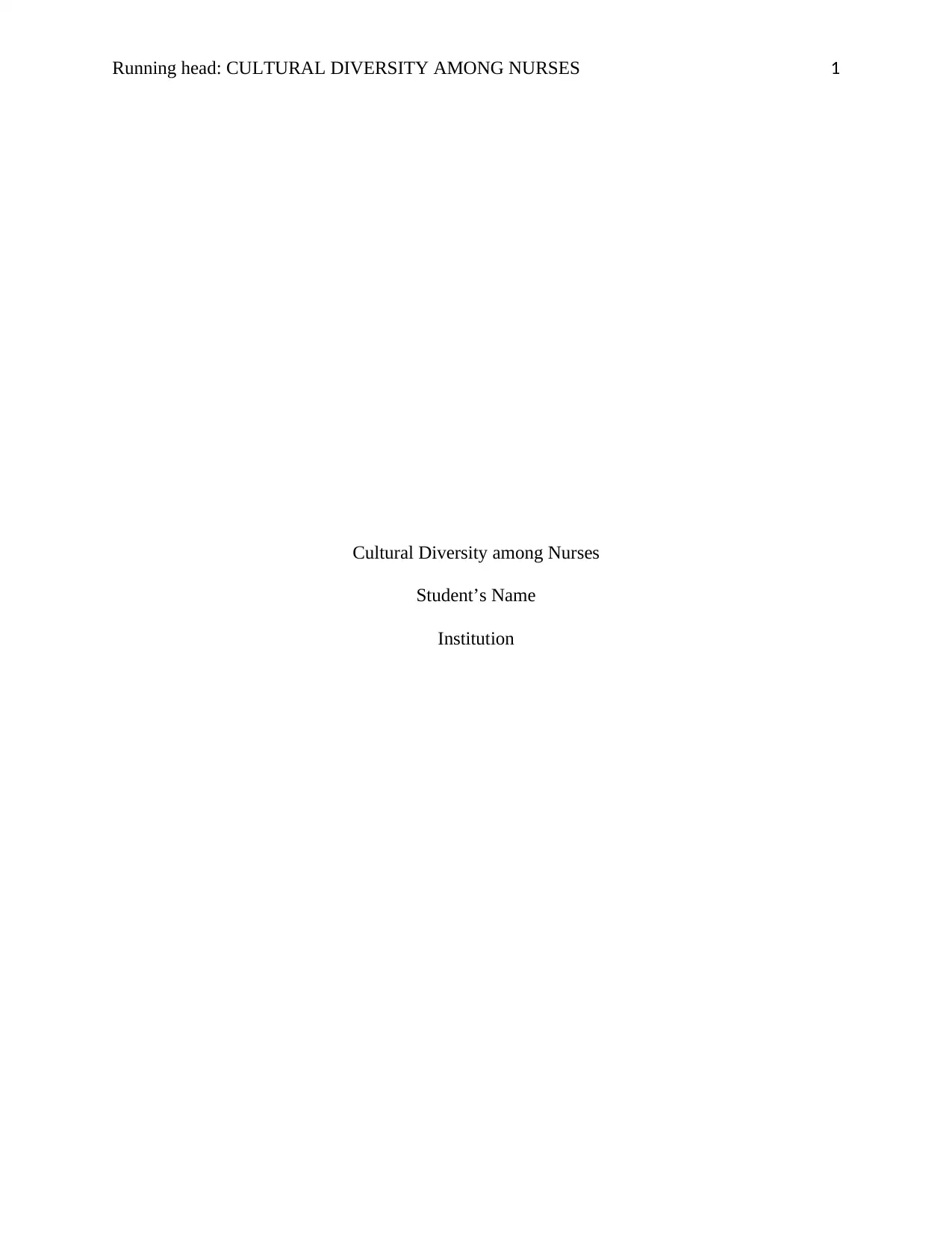
Running head: CULTURAL DIVERSITY AMONG NURSES 1
Cultural Diversity among Nurses
Student’s Name
Institution
Cultural Diversity among Nurses
Student’s Name
Institution
Paraphrase This Document
Need a fresh take? Get an instant paraphrase of this document with our AI Paraphraser
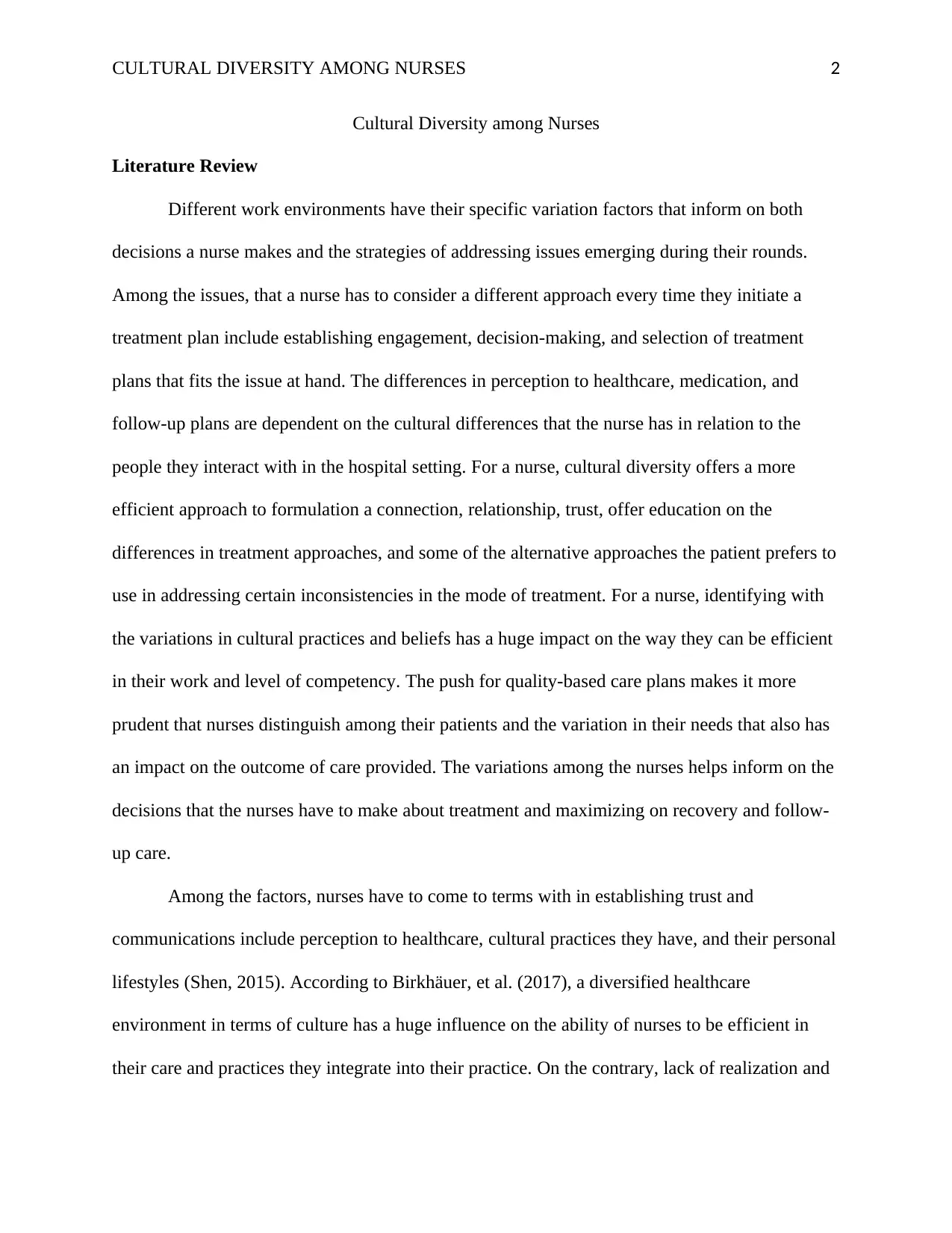
CULTURAL DIVERSITY AMONG NURSES 2
Cultural Diversity among Nurses
Literature Review
Different work environments have their specific variation factors that inform on both
decisions a nurse makes and the strategies of addressing issues emerging during their rounds.
Among the issues, that a nurse has to consider a different approach every time they initiate a
treatment plan include establishing engagement, decision-making, and selection of treatment
plans that fits the issue at hand. The differences in perception to healthcare, medication, and
follow-up plans are dependent on the cultural differences that the nurse has in relation to the
people they interact with in the hospital setting. For a nurse, cultural diversity offers a more
efficient approach to formulation a connection, relationship, trust, offer education on the
differences in treatment approaches, and some of the alternative approaches the patient prefers to
use in addressing certain inconsistencies in the mode of treatment. For a nurse, identifying with
the variations in cultural practices and beliefs has a huge impact on the way they can be efficient
in their work and level of competency. The push for quality-based care plans makes it more
prudent that nurses distinguish among their patients and the variation in their needs that also has
an impact on the outcome of care provided. The variations among the nurses helps inform on the
decisions that the nurses have to make about treatment and maximizing on recovery and follow-
up care.
Among the factors, nurses have to come to terms with in establishing trust and
communications include perception to healthcare, cultural practices they have, and their personal
lifestyles (Shen, 2015). According to Birkhäuer, et al. (2017), a diversified healthcare
environment in terms of culture has a huge influence on the ability of nurses to be efficient in
their care and practices they integrate into their practice. On the contrary, lack of realization and
Cultural Diversity among Nurses
Literature Review
Different work environments have their specific variation factors that inform on both
decisions a nurse makes and the strategies of addressing issues emerging during their rounds.
Among the issues, that a nurse has to consider a different approach every time they initiate a
treatment plan include establishing engagement, decision-making, and selection of treatment
plans that fits the issue at hand. The differences in perception to healthcare, medication, and
follow-up plans are dependent on the cultural differences that the nurse has in relation to the
people they interact with in the hospital setting. For a nurse, cultural diversity offers a more
efficient approach to formulation a connection, relationship, trust, offer education on the
differences in treatment approaches, and some of the alternative approaches the patient prefers to
use in addressing certain inconsistencies in the mode of treatment. For a nurse, identifying with
the variations in cultural practices and beliefs has a huge impact on the way they can be efficient
in their work and level of competency. The push for quality-based care plans makes it more
prudent that nurses distinguish among their patients and the variation in their needs that also has
an impact on the outcome of care provided. The variations among the nurses helps inform on the
decisions that the nurses have to make about treatment and maximizing on recovery and follow-
up care.
Among the factors, nurses have to come to terms with in establishing trust and
communications include perception to healthcare, cultural practices they have, and their personal
lifestyles (Shen, 2015). According to Birkhäuer, et al. (2017), a diversified healthcare
environment in terms of culture has a huge influence on the ability of nurses to be efficient in
their care and practices they integrate into their practice. On the contrary, lack of realization and
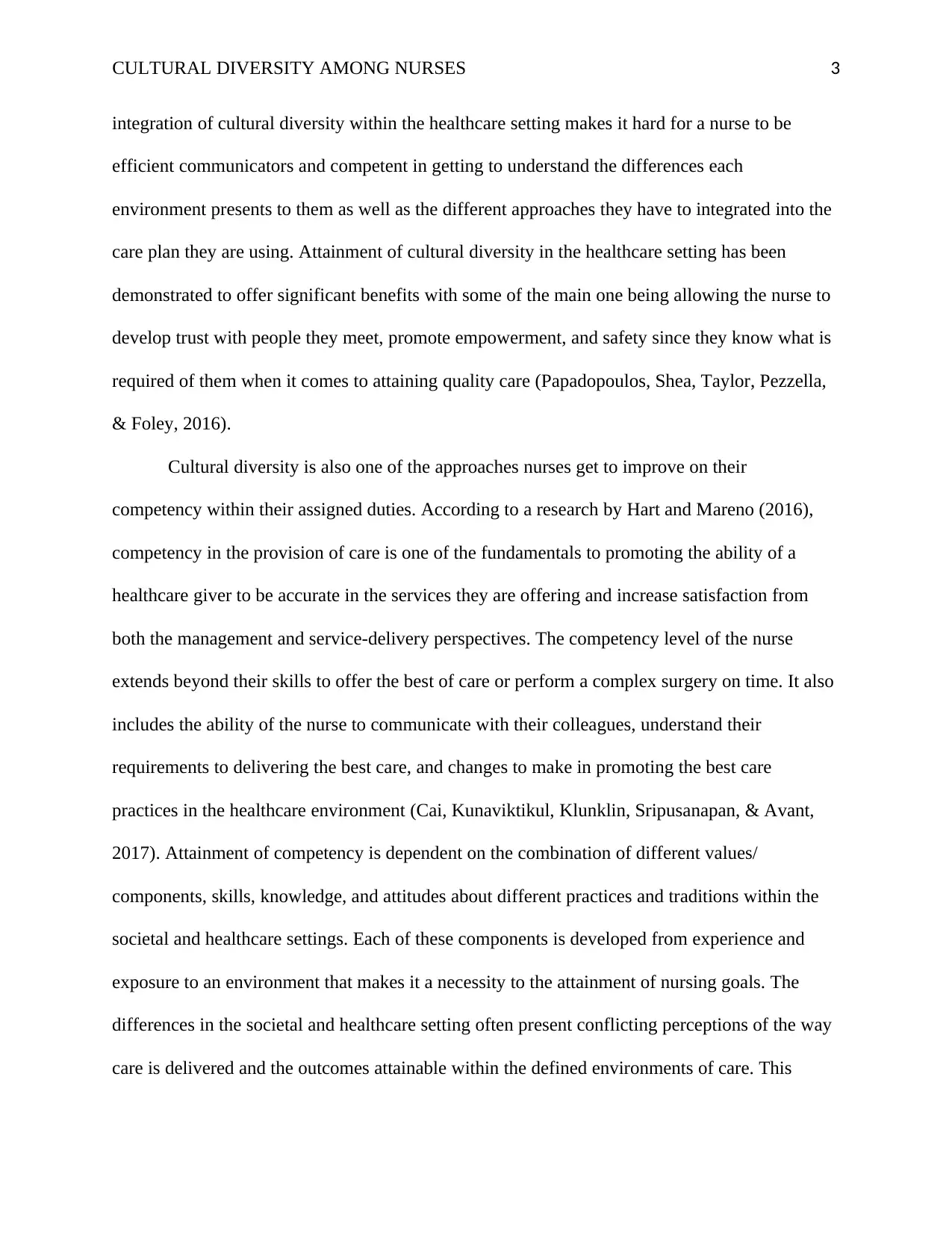
CULTURAL DIVERSITY AMONG NURSES 3
integration of cultural diversity within the healthcare setting makes it hard for a nurse to be
efficient communicators and competent in getting to understand the differences each
environment presents to them as well as the different approaches they have to integrated into the
care plan they are using. Attainment of cultural diversity in the healthcare setting has been
demonstrated to offer significant benefits with some of the main one being allowing the nurse to
develop trust with people they meet, promote empowerment, and safety since they know what is
required of them when it comes to attaining quality care (Papadopoulos, Shea, Taylor, Pezzella,
& Foley, 2016).
Cultural diversity is also one of the approaches nurses get to improve on their
competency within their assigned duties. According to a research by Hart and Mareno (2016),
competency in the provision of care is one of the fundamentals to promoting the ability of a
healthcare giver to be accurate in the services they are offering and increase satisfaction from
both the management and service-delivery perspectives. The competency level of the nurse
extends beyond their skills to offer the best of care or perform a complex surgery on time. It also
includes the ability of the nurse to communicate with their colleagues, understand their
requirements to delivering the best care, and changes to make in promoting the best care
practices in the healthcare environment (Cai, Kunaviktikul, Klunklin, Sripusanapan, & Avant,
2017). Attainment of competency is dependent on the combination of different values/
components, skills, knowledge, and attitudes about different practices and traditions within the
societal and healthcare settings. Each of these components is developed from experience and
exposure to an environment that makes it a necessity to the attainment of nursing goals. The
differences in the societal and healthcare setting often present conflicting perceptions of the way
care is delivered and the outcomes attainable within the defined environments of care. This
integration of cultural diversity within the healthcare setting makes it hard for a nurse to be
efficient communicators and competent in getting to understand the differences each
environment presents to them as well as the different approaches they have to integrated into the
care plan they are using. Attainment of cultural diversity in the healthcare setting has been
demonstrated to offer significant benefits with some of the main one being allowing the nurse to
develop trust with people they meet, promote empowerment, and safety since they know what is
required of them when it comes to attaining quality care (Papadopoulos, Shea, Taylor, Pezzella,
& Foley, 2016).
Cultural diversity is also one of the approaches nurses get to improve on their
competency within their assigned duties. According to a research by Hart and Mareno (2016),
competency in the provision of care is one of the fundamentals to promoting the ability of a
healthcare giver to be accurate in the services they are offering and increase satisfaction from
both the management and service-delivery perspectives. The competency level of the nurse
extends beyond their skills to offer the best of care or perform a complex surgery on time. It also
includes the ability of the nurse to communicate with their colleagues, understand their
requirements to delivering the best care, and changes to make in promoting the best care
practices in the healthcare environment (Cai, Kunaviktikul, Klunklin, Sripusanapan, & Avant,
2017). Attainment of competency is dependent on the combination of different values/
components, skills, knowledge, and attitudes about different practices and traditions within the
societal and healthcare settings. Each of these components is developed from experience and
exposure to an environment that makes it a necessity to the attainment of nursing goals. The
differences in the societal and healthcare setting often present conflicting perceptions of the way
care is delivered and the outcomes attainable within the defined environments of care. This
⊘ This is a preview!⊘
Do you want full access?
Subscribe today to unlock all pages.

Trusted by 1+ million students worldwide
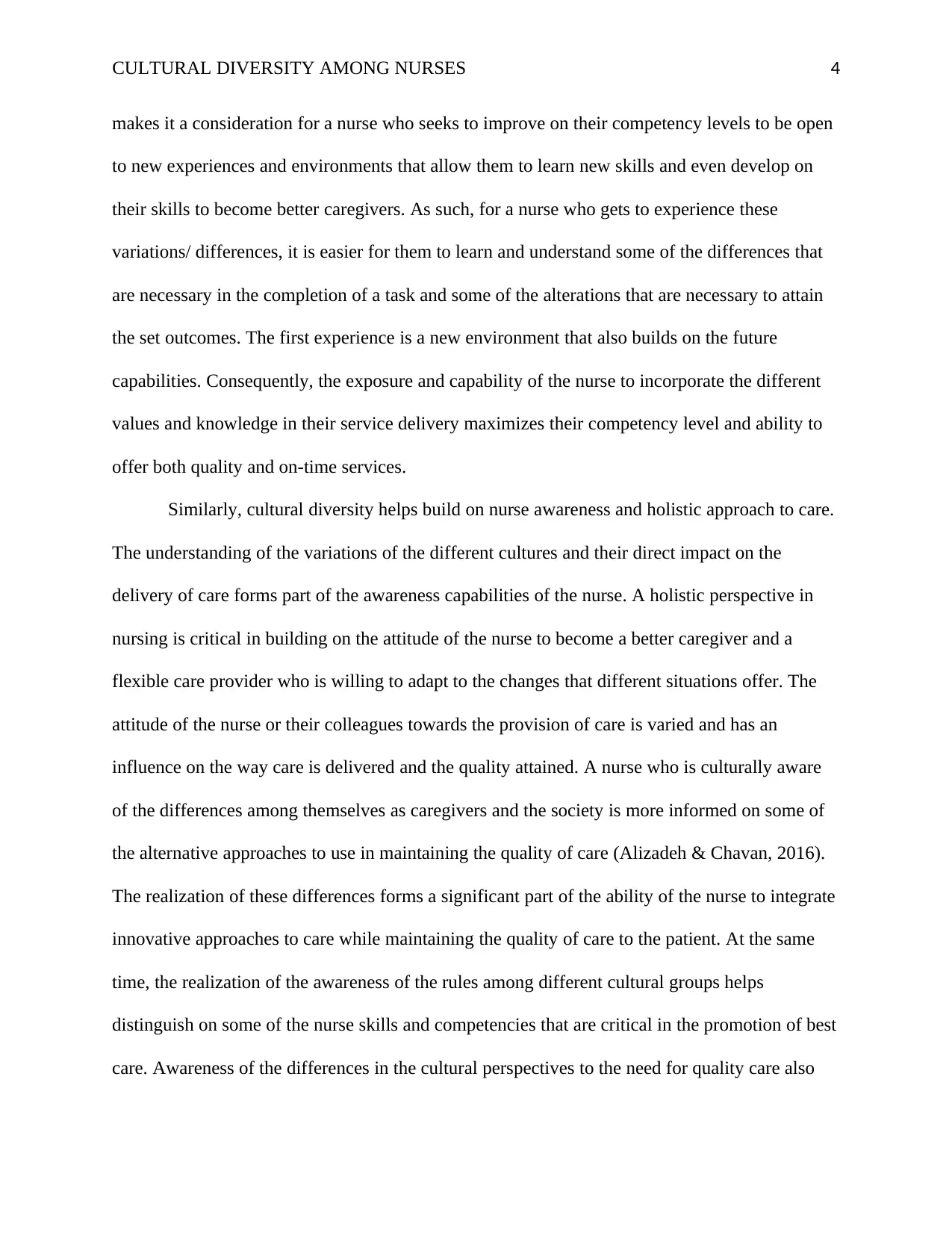
CULTURAL DIVERSITY AMONG NURSES 4
makes it a consideration for a nurse who seeks to improve on their competency levels to be open
to new experiences and environments that allow them to learn new skills and even develop on
their skills to become better caregivers. As such, for a nurse who gets to experience these
variations/ differences, it is easier for them to learn and understand some of the differences that
are necessary in the completion of a task and some of the alterations that are necessary to attain
the set outcomes. The first experience is a new environment that also builds on the future
capabilities. Consequently, the exposure and capability of the nurse to incorporate the different
values and knowledge in their service delivery maximizes their competency level and ability to
offer both quality and on-time services.
Similarly, cultural diversity helps build on nurse awareness and holistic approach to care.
The understanding of the variations of the different cultures and their direct impact on the
delivery of care forms part of the awareness capabilities of the nurse. A holistic perspective in
nursing is critical in building on the attitude of the nurse to become a better caregiver and a
flexible care provider who is willing to adapt to the changes that different situations offer. The
attitude of the nurse or their colleagues towards the provision of care is varied and has an
influence on the way care is delivered and the quality attained. A nurse who is culturally aware
of the differences among themselves as caregivers and the society is more informed on some of
the alternative approaches to use in maintaining the quality of care (Alizadeh & Chavan, 2016).
The realization of these differences forms a significant part of the ability of the nurse to integrate
innovative approaches to care while maintaining the quality of care to the patient. At the same
time, the realization of the awareness of the rules among different cultural groups helps
distinguish on some of the nurse skills and competencies that are critical in the promotion of best
care. Awareness of the differences in the cultural perspectives to the need for quality care also
makes it a consideration for a nurse who seeks to improve on their competency levels to be open
to new experiences and environments that allow them to learn new skills and even develop on
their skills to become better caregivers. As such, for a nurse who gets to experience these
variations/ differences, it is easier for them to learn and understand some of the differences that
are necessary in the completion of a task and some of the alterations that are necessary to attain
the set outcomes. The first experience is a new environment that also builds on the future
capabilities. Consequently, the exposure and capability of the nurse to incorporate the different
values and knowledge in their service delivery maximizes their competency level and ability to
offer both quality and on-time services.
Similarly, cultural diversity helps build on nurse awareness and holistic approach to care.
The understanding of the variations of the different cultures and their direct impact on the
delivery of care forms part of the awareness capabilities of the nurse. A holistic perspective in
nursing is critical in building on the attitude of the nurse to become a better caregiver and a
flexible care provider who is willing to adapt to the changes that different situations offer. The
attitude of the nurse or their colleagues towards the provision of care is varied and has an
influence on the way care is delivered and the quality attained. A nurse who is culturally aware
of the differences among themselves as caregivers and the society is more informed on some of
the alternative approaches to use in maintaining the quality of care (Alizadeh & Chavan, 2016).
The realization of these differences forms a significant part of the ability of the nurse to integrate
innovative approaches to care while maintaining the quality of care to the patient. At the same
time, the realization of the awareness of the rules among different cultural groups helps
distinguish on some of the nurse skills and competencies that are critical in the promotion of best
care. Awareness of the differences in the cultural perspectives to the need for quality care also
Paraphrase This Document
Need a fresh take? Get an instant paraphrase of this document with our AI Paraphraser
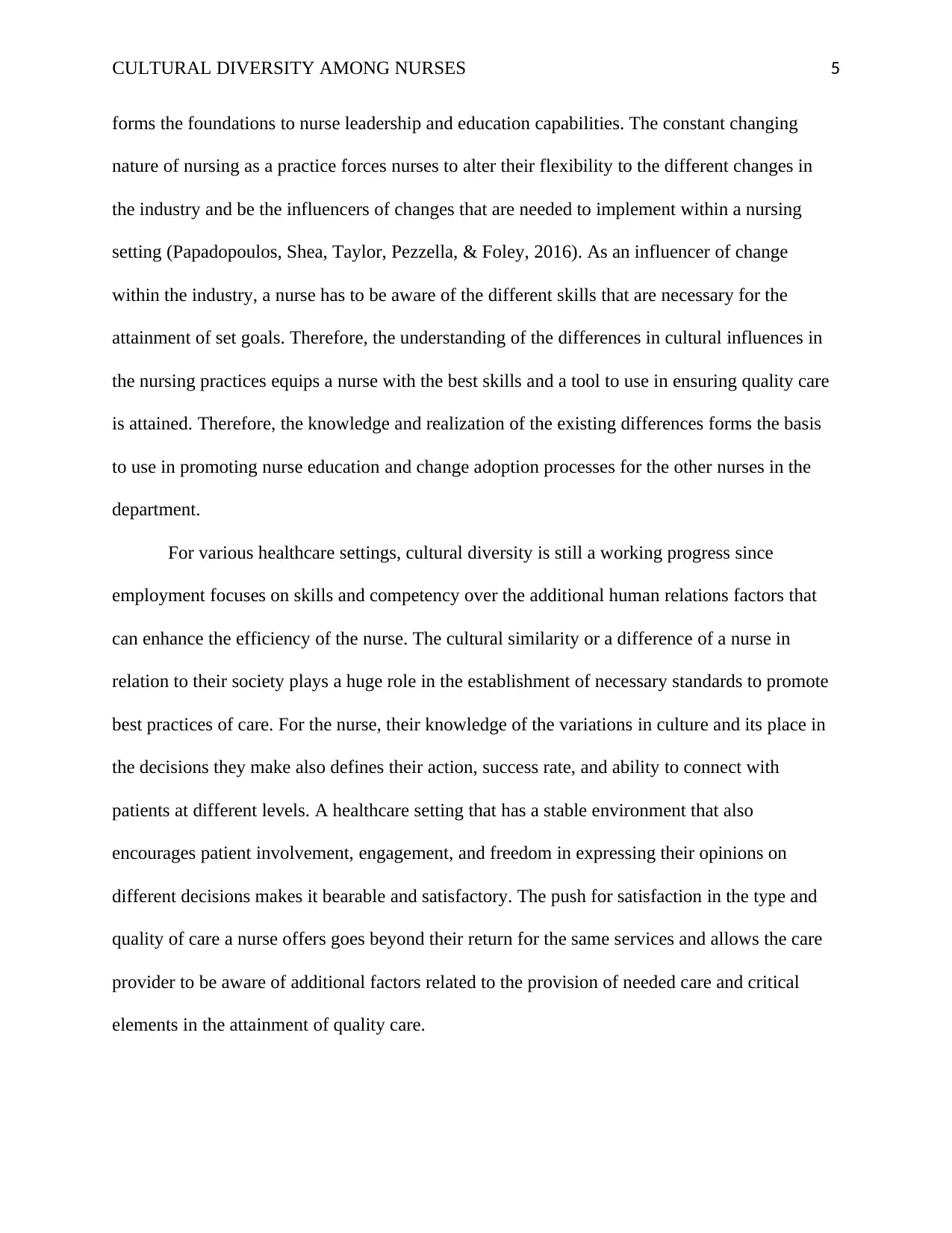
CULTURAL DIVERSITY AMONG NURSES 5
forms the foundations to nurse leadership and education capabilities. The constant changing
nature of nursing as a practice forces nurses to alter their flexibility to the different changes in
the industry and be the influencers of changes that are needed to implement within a nursing
setting (Papadopoulos, Shea, Taylor, Pezzella, & Foley, 2016). As an influencer of change
within the industry, a nurse has to be aware of the different skills that are necessary for the
attainment of set goals. Therefore, the understanding of the differences in cultural influences in
the nursing practices equips a nurse with the best skills and a tool to use in ensuring quality care
is attained. Therefore, the knowledge and realization of the existing differences forms the basis
to use in promoting nurse education and change adoption processes for the other nurses in the
department.
For various healthcare settings, cultural diversity is still a working progress since
employment focuses on skills and competency over the additional human relations factors that
can enhance the efficiency of the nurse. The cultural similarity or a difference of a nurse in
relation to their society plays a huge role in the establishment of necessary standards to promote
best practices of care. For the nurse, their knowledge of the variations in culture and its place in
the decisions they make also defines their action, success rate, and ability to connect with
patients at different levels. A healthcare setting that has a stable environment that also
encourages patient involvement, engagement, and freedom in expressing their opinions on
different decisions makes it bearable and satisfactory. The push for satisfaction in the type and
quality of care a nurse offers goes beyond their return for the same services and allows the care
provider to be aware of additional factors related to the provision of needed care and critical
elements in the attainment of quality care.
forms the foundations to nurse leadership and education capabilities. The constant changing
nature of nursing as a practice forces nurses to alter their flexibility to the different changes in
the industry and be the influencers of changes that are needed to implement within a nursing
setting (Papadopoulos, Shea, Taylor, Pezzella, & Foley, 2016). As an influencer of change
within the industry, a nurse has to be aware of the different skills that are necessary for the
attainment of set goals. Therefore, the understanding of the differences in cultural influences in
the nursing practices equips a nurse with the best skills and a tool to use in ensuring quality care
is attained. Therefore, the knowledge and realization of the existing differences forms the basis
to use in promoting nurse education and change adoption processes for the other nurses in the
department.
For various healthcare settings, cultural diversity is still a working progress since
employment focuses on skills and competency over the additional human relations factors that
can enhance the efficiency of the nurse. The cultural similarity or a difference of a nurse in
relation to their society plays a huge role in the establishment of necessary standards to promote
best practices of care. For the nurse, their knowledge of the variations in culture and its place in
the decisions they make also defines their action, success rate, and ability to connect with
patients at different levels. A healthcare setting that has a stable environment that also
encourages patient involvement, engagement, and freedom in expressing their opinions on
different decisions makes it bearable and satisfactory. The push for satisfaction in the type and
quality of care a nurse offers goes beyond their return for the same services and allows the care
provider to be aware of additional factors related to the provision of needed care and critical
elements in the attainment of quality care.
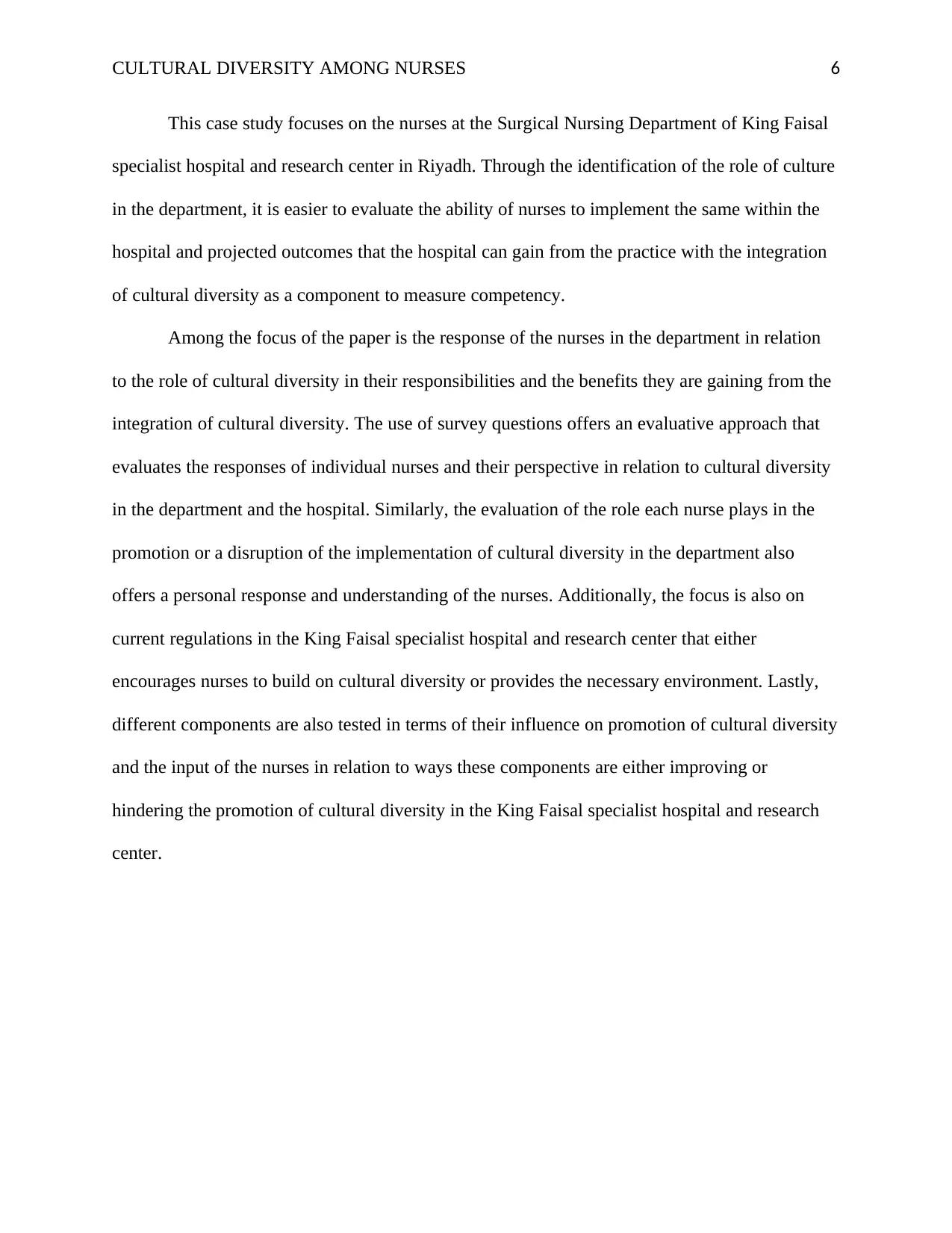
CULTURAL DIVERSITY AMONG NURSES 6
This case study focuses on the nurses at the Surgical Nursing Department of King Faisal
specialist hospital and research center in Riyadh. Through the identification of the role of culture
in the department, it is easier to evaluate the ability of nurses to implement the same within the
hospital and projected outcomes that the hospital can gain from the practice with the integration
of cultural diversity as a component to measure competency.
Among the focus of the paper is the response of the nurses in the department in relation
to the role of cultural diversity in their responsibilities and the benefits they are gaining from the
integration of cultural diversity. The use of survey questions offers an evaluative approach that
evaluates the responses of individual nurses and their perspective in relation to cultural diversity
in the department and the hospital. Similarly, the evaluation of the role each nurse plays in the
promotion or a disruption of the implementation of cultural diversity in the department also
offers a personal response and understanding of the nurses. Additionally, the focus is also on
current regulations in the King Faisal specialist hospital and research center that either
encourages nurses to build on cultural diversity or provides the necessary environment. Lastly,
different components are also tested in terms of their influence on promotion of cultural diversity
and the input of the nurses in relation to ways these components are either improving or
hindering the promotion of cultural diversity in the King Faisal specialist hospital and research
center.
This case study focuses on the nurses at the Surgical Nursing Department of King Faisal
specialist hospital and research center in Riyadh. Through the identification of the role of culture
in the department, it is easier to evaluate the ability of nurses to implement the same within the
hospital and projected outcomes that the hospital can gain from the practice with the integration
of cultural diversity as a component to measure competency.
Among the focus of the paper is the response of the nurses in the department in relation
to the role of cultural diversity in their responsibilities and the benefits they are gaining from the
integration of cultural diversity. The use of survey questions offers an evaluative approach that
evaluates the responses of individual nurses and their perspective in relation to cultural diversity
in the department and the hospital. Similarly, the evaluation of the role each nurse plays in the
promotion or a disruption of the implementation of cultural diversity in the department also
offers a personal response and understanding of the nurses. Additionally, the focus is also on
current regulations in the King Faisal specialist hospital and research center that either
encourages nurses to build on cultural diversity or provides the necessary environment. Lastly,
different components are also tested in terms of their influence on promotion of cultural diversity
and the input of the nurses in relation to ways these components are either improving or
hindering the promotion of cultural diversity in the King Faisal specialist hospital and research
center.
⊘ This is a preview!⊘
Do you want full access?
Subscribe today to unlock all pages.

Trusted by 1+ million students worldwide
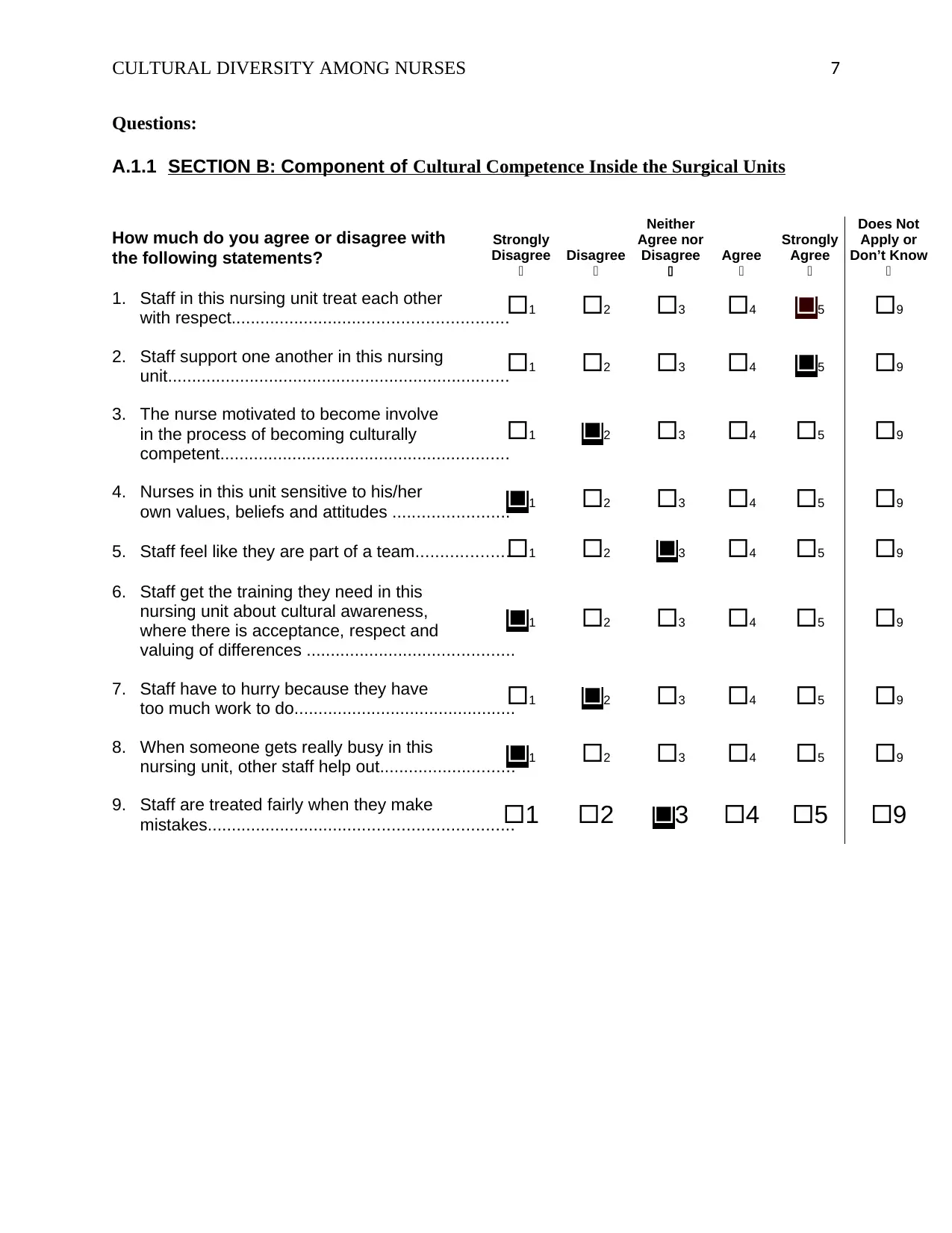
CULTURAL DIVERSITY AMONG NURSES 7
Questions:
A.1.1 SECTION B: Component of Cultural Competence Inside the Surgical Units
How much do you agree or disagree with
the following statements?
Strongly
Disagree
Disagree
Neither
Agree nor
Disagree
Agree
Strongly
Agree
Does Not
Apply or
Don’t Know
1. Staff in this nursing unit treat each other
with respect.........................................................1 2 3 4 5 9
2. Staff support one another in this nursing
unit.......................................................................1 2 3 4 5 9
3. The nurse motivated to become involve
in the process of becoming culturally
competent............................................................
1 2 3 4 5 9
4. Nurses in this unit sensitive to his/her
own values, beliefs and attitudes ........................
1 2 3 4 5 9
5. Staff feel like they are part of a team...................1 2 3 4 5 9
6. Staff get the training they need in this
nursing unit about cultural awareness,
where there is acceptance, respect and
valuing of differences ...........................................
1 2 3 4 5 9
7. Staff have to hurry because they have
too much work to do..............................................
1 2 3 4 5 9
8. When someone gets really busy in this
nursing unit, other staff help out............................
1 2 3 4 5 9
9. Staff are treated fairly when they make
mistakes...............................................................1 2 3 4 5 9
Questions:
A.1.1 SECTION B: Component of Cultural Competence Inside the Surgical Units
How much do you agree or disagree with
the following statements?
Strongly
Disagree
Disagree
Neither
Agree nor
Disagree
Agree
Strongly
Agree
Does Not
Apply or
Don’t Know
1. Staff in this nursing unit treat each other
with respect.........................................................1 2 3 4 5 9
2. Staff support one another in this nursing
unit.......................................................................1 2 3 4 5 9
3. The nurse motivated to become involve
in the process of becoming culturally
competent............................................................
1 2 3 4 5 9
4. Nurses in this unit sensitive to his/her
own values, beliefs and attitudes ........................
1 2 3 4 5 9
5. Staff feel like they are part of a team...................1 2 3 4 5 9
6. Staff get the training they need in this
nursing unit about cultural awareness,
where there is acceptance, respect and
valuing of differences ...........................................
1 2 3 4 5 9
7. Staff have to hurry because they have
too much work to do..............................................
1 2 3 4 5 9
8. When someone gets really busy in this
nursing unit, other staff help out............................
1 2 3 4 5 9
9. Staff are treated fairly when they make
mistakes...............................................................1 2 3 4 5 9
Paraphrase This Document
Need a fresh take? Get an instant paraphrase of this document with our AI Paraphraser
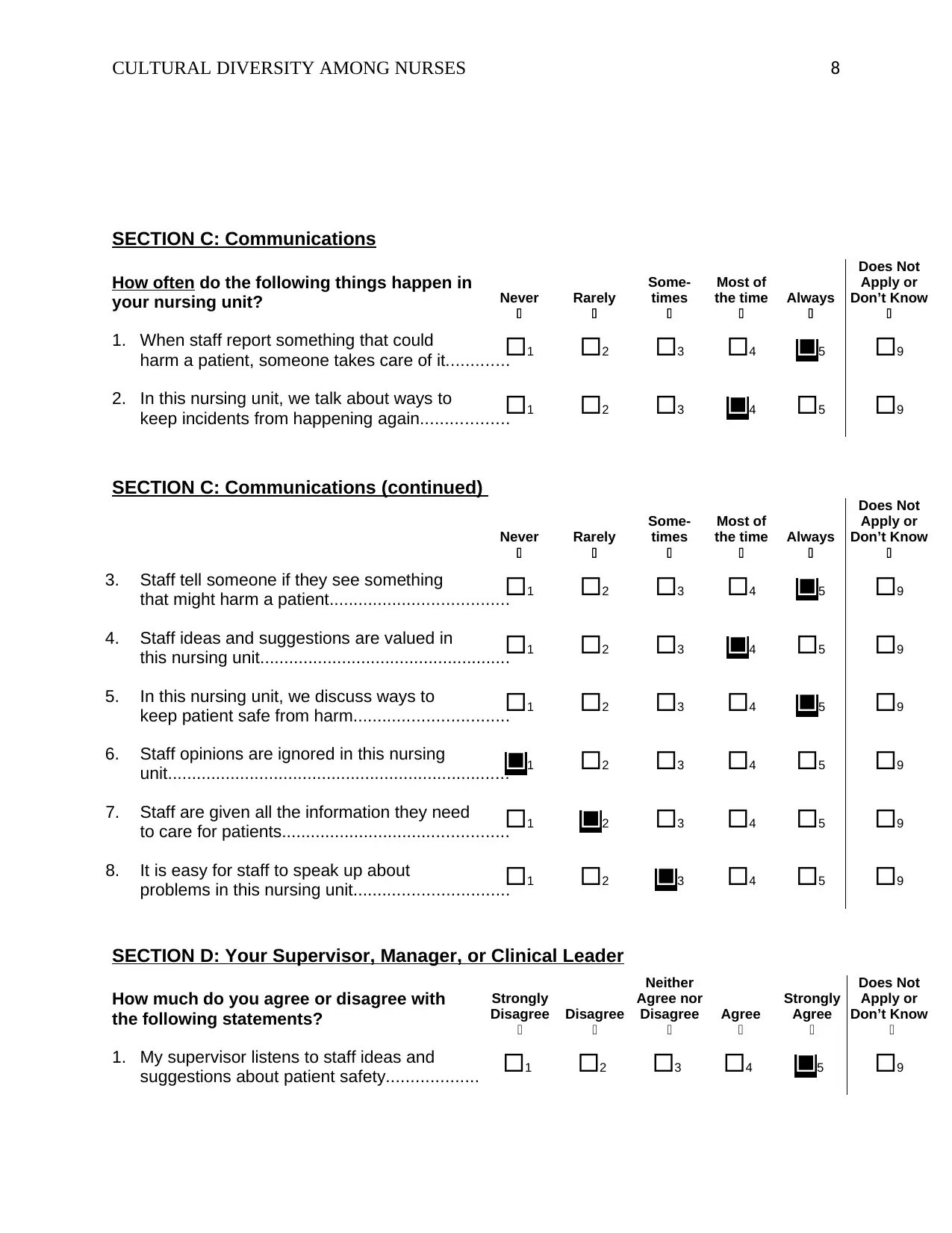
CULTURAL DIVERSITY AMONG NURSES 8
SECTION C: Communications
How often do the following things happen in
your nursing unit? Never
Rarely
Some-
times
Most of
the time
Always
Does Not
Apply or
Don’t Know
1. When staff report something that could
harm a patient, someone takes care of it.............
1 2 3 4 5 9
2. In this nursing unit, we talk about ways to
keep incidents from happening again..................
1 2 3 4 5 9
SECTION C: Communications (continued)
Never
Rarely
Some-
times
Most of
the time
Always
Does Not
Apply or
Don’t Know
3. Staff tell someone if they see something
that might harm a patient.....................................
1 2 3 4 5 9
4. Staff ideas and suggestions are valued in
this nursing unit....................................................
1 2 3 4 5 9
5. In this nursing unit, we discuss ways to
keep patient safe from harm................................
1 2 3 4 5 9
6. Staff opinions are ignored in this nursing
unit.......................................................................
1 2 3 4 5 9
7. Staff are given all the information they need
to care for patients...............................................
1 2 3 4 5 9
8. It is easy for staff to speak up about
problems in this nursing unit................................
1 2 3 4 5 9
SECTION D: Your Supervisor, Manager, or Clinical Leader
How much do you agree or disagree with
the following statements?
Strongly
Disagree
Disagree
Neither
Agree nor
Disagree
Agree
Strongly
Agree
Does Not
Apply or
Don’t Know
1. My supervisor listens to staff ideas and
suggestions about patient safety.........................
1 2 3 4 5 9
SECTION C: Communications
How often do the following things happen in
your nursing unit? Never
Rarely
Some-
times
Most of
the time
Always
Does Not
Apply or
Don’t Know
1. When staff report something that could
harm a patient, someone takes care of it.............
1 2 3 4 5 9
2. In this nursing unit, we talk about ways to
keep incidents from happening again..................
1 2 3 4 5 9
SECTION C: Communications (continued)
Never
Rarely
Some-
times
Most of
the time
Always
Does Not
Apply or
Don’t Know
3. Staff tell someone if they see something
that might harm a patient.....................................
1 2 3 4 5 9
4. Staff ideas and suggestions are valued in
this nursing unit....................................................
1 2 3 4 5 9
5. In this nursing unit, we discuss ways to
keep patient safe from harm................................
1 2 3 4 5 9
6. Staff opinions are ignored in this nursing
unit.......................................................................
1 2 3 4 5 9
7. Staff are given all the information they need
to care for patients...............................................
1 2 3 4 5 9
8. It is easy for staff to speak up about
problems in this nursing unit................................
1 2 3 4 5 9
SECTION D: Your Supervisor, Manager, or Clinical Leader
How much do you agree or disagree with
the following statements?
Strongly
Disagree
Disagree
Neither
Agree nor
Disagree
Agree
Strongly
Agree
Does Not
Apply or
Don’t Know
1. My supervisor listens to staff ideas and
suggestions about patient safety.........................
1 2 3 4 5 9
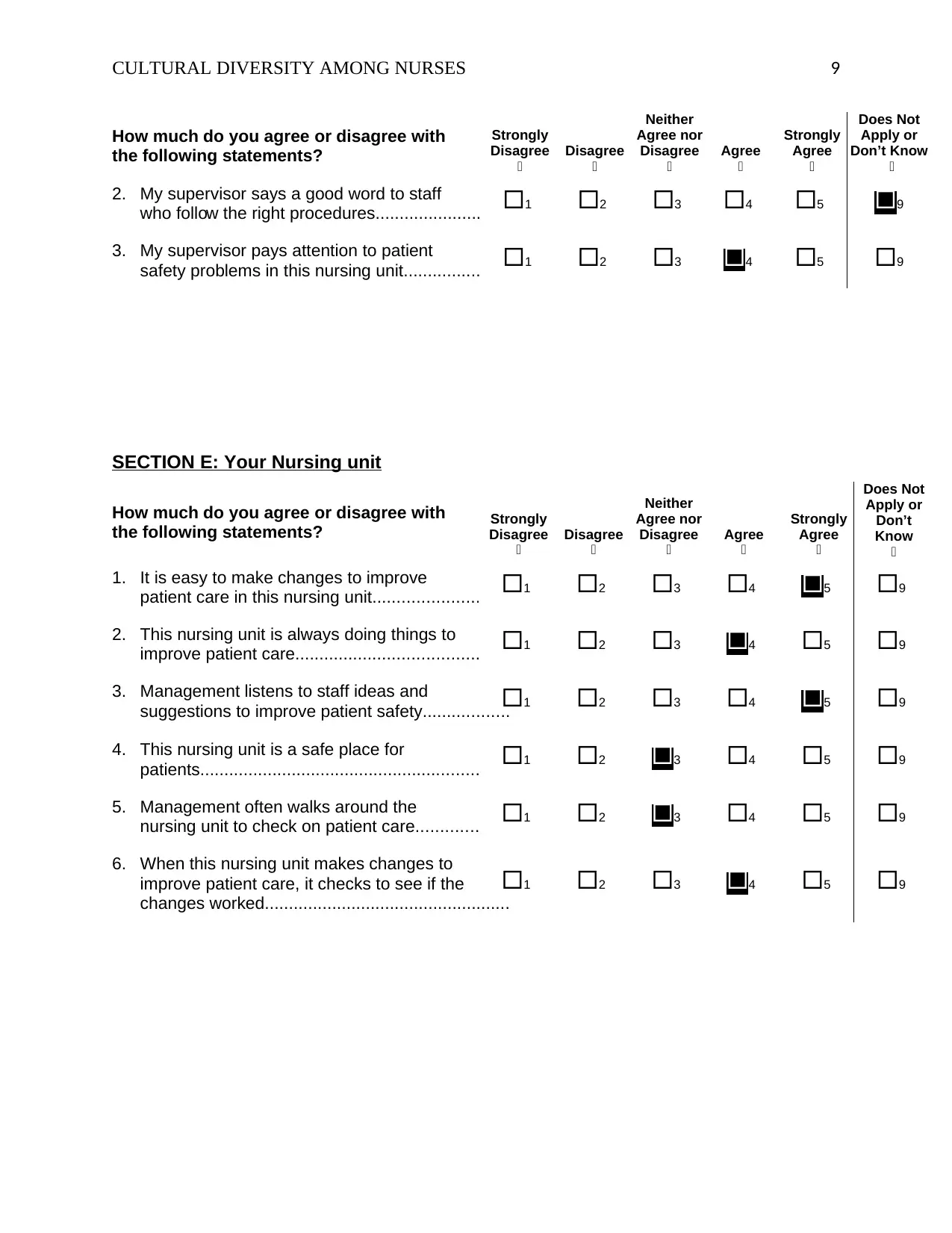
CULTURAL DIVERSITY AMONG NURSES 9
How much do you agree or disagree with
the following statements?
Strongly
Disagree
Disagree
Neither
Agree nor
Disagree
Agree
Strongly
Agree
Does Not
Apply or
Don’t Know
2. My supervisor says a good word to staff
who follow the right procedures............................
1 2 3 4 5 9
3. My supervisor pays attention to patient
safety problems in this nursing unit......................
1 2 3 4 5 9
SECTION E: Your Nursing unit
How much do you agree or disagree with
the following statements? Strongly
Disagree
Disagree
Neither
Agree nor
Disagree
Agree
Strongly
Agree
Does Not
Apply or
Don’t
Know
1. It is easy to make changes to improve
patient care in this nursing unit............................
1 2 3 4 5 9
2. This nursing unit is always doing things to
improve patient care............................................
1 2 3 4 5 9
3. Management listens to staff ideas and
suggestions to improve patient safety..................
1 2 3 4 5 9
4. This nursing unit is a safe place for
patients................................................................
1 2 3 4 5 9
5. Management often walks around the
nursing unit to check on patient care...................
1 2 3 4 5 9
6. When this nursing unit makes changes to
improve patient care, it checks to see if the
changes worked...................................................
1 2 3 4 5 9
How much do you agree or disagree with
the following statements?
Strongly
Disagree
Disagree
Neither
Agree nor
Disagree
Agree
Strongly
Agree
Does Not
Apply or
Don’t Know
2. My supervisor says a good word to staff
who follow the right procedures............................
1 2 3 4 5 9
3. My supervisor pays attention to patient
safety problems in this nursing unit......................
1 2 3 4 5 9
SECTION E: Your Nursing unit
How much do you agree or disagree with
the following statements? Strongly
Disagree
Disagree
Neither
Agree nor
Disagree
Agree
Strongly
Agree
Does Not
Apply or
Don’t
Know
1. It is easy to make changes to improve
patient care in this nursing unit............................
1 2 3 4 5 9
2. This nursing unit is always doing things to
improve patient care............................................
1 2 3 4 5 9
3. Management listens to staff ideas and
suggestions to improve patient safety..................
1 2 3 4 5 9
4. This nursing unit is a safe place for
patients................................................................
1 2 3 4 5 9
5. Management often walks around the
nursing unit to check on patient care...................
1 2 3 4 5 9
6. When this nursing unit makes changes to
improve patient care, it checks to see if the
changes worked...................................................
1 2 3 4 5 9
⊘ This is a preview!⊘
Do you want full access?
Subscribe today to unlock all pages.

Trusted by 1+ million students worldwide
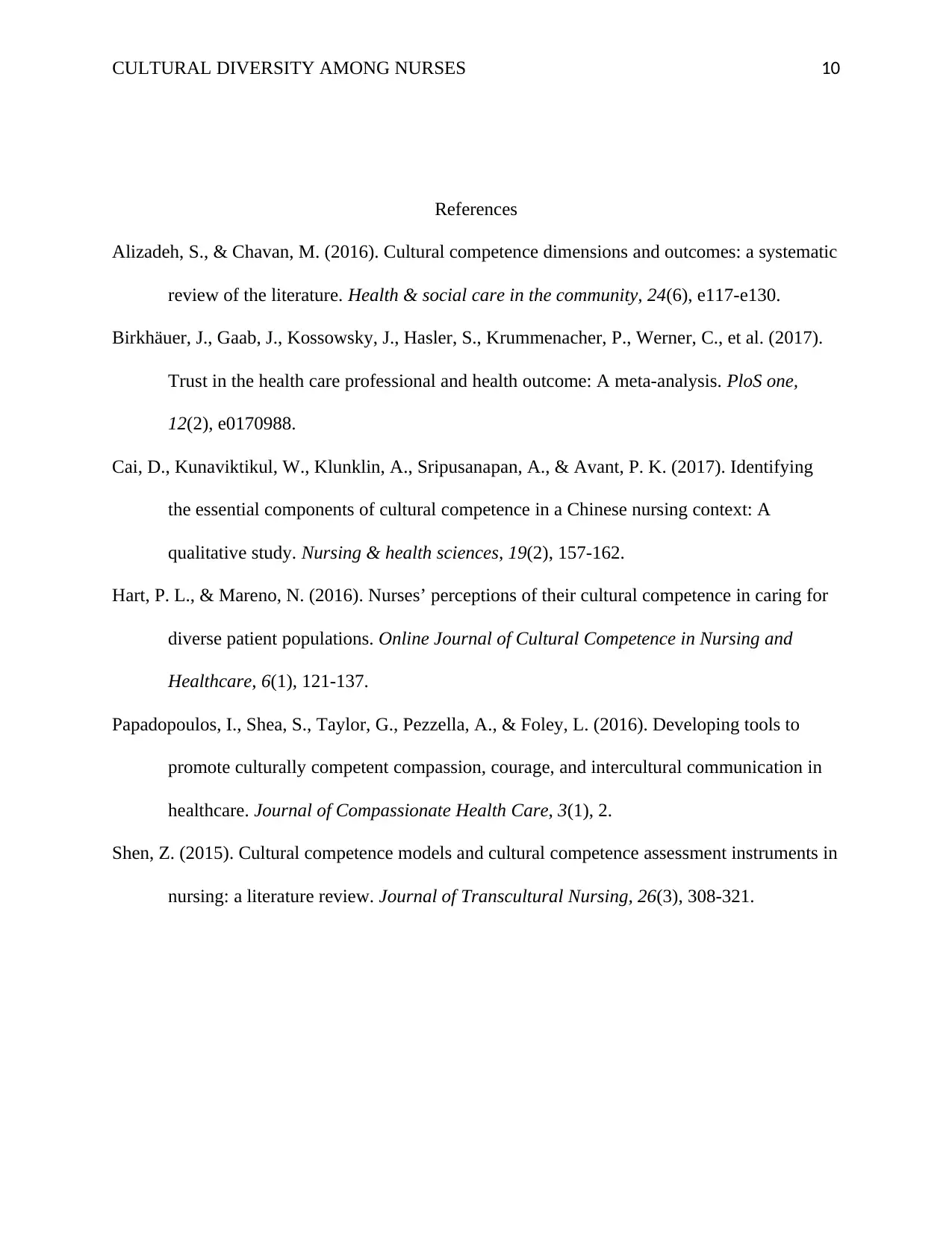
CULTURAL DIVERSITY AMONG NURSES 10
References
Alizadeh, S., & Chavan, M. (2016). Cultural competence dimensions and outcomes: a systematic
review of the literature. Health & social care in the community, 24(6), e117-e130.
Birkhäuer, J., Gaab, J., Kossowsky, J., Hasler, S., Krummenacher, P., Werner, C., et al. (2017).
Trust in the health care professional and health outcome: A meta-analysis. PloS one,
12(2), e0170988.
Cai, D., Kunaviktikul, W., Klunklin, A., Sripusanapan, A., & Avant, P. K. (2017). Identifying
the essential components of cultural competence in a Chinese nursing context: A
qualitative study. Nursing & health sciences, 19(2), 157-162.
Hart, P. L., & Mareno, N. (2016). Nurses’ perceptions of their cultural competence in caring for
diverse patient populations. Online Journal of Cultural Competence in Nursing and
Healthcare, 6(1), 121-137.
Papadopoulos, I., Shea, S., Taylor, G., Pezzella, A., & Foley, L. (2016). Developing tools to
promote culturally competent compassion, courage, and intercultural communication in
healthcare. Journal of Compassionate Health Care, 3(1), 2.
Shen, Z. (2015). Cultural competence models and cultural competence assessment instruments in
nursing: a literature review. Journal of Transcultural Nursing, 26(3), 308-321.
References
Alizadeh, S., & Chavan, M. (2016). Cultural competence dimensions and outcomes: a systematic
review of the literature. Health & social care in the community, 24(6), e117-e130.
Birkhäuer, J., Gaab, J., Kossowsky, J., Hasler, S., Krummenacher, P., Werner, C., et al. (2017).
Trust in the health care professional and health outcome: A meta-analysis. PloS one,
12(2), e0170988.
Cai, D., Kunaviktikul, W., Klunklin, A., Sripusanapan, A., & Avant, P. K. (2017). Identifying
the essential components of cultural competence in a Chinese nursing context: A
qualitative study. Nursing & health sciences, 19(2), 157-162.
Hart, P. L., & Mareno, N. (2016). Nurses’ perceptions of their cultural competence in caring for
diverse patient populations. Online Journal of Cultural Competence in Nursing and
Healthcare, 6(1), 121-137.
Papadopoulos, I., Shea, S., Taylor, G., Pezzella, A., & Foley, L. (2016). Developing tools to
promote culturally competent compassion, courage, and intercultural communication in
healthcare. Journal of Compassionate Health Care, 3(1), 2.
Shen, Z. (2015). Cultural competence models and cultural competence assessment instruments in
nursing: a literature review. Journal of Transcultural Nursing, 26(3), 308-321.
1 out of 10
Related Documents
Your All-in-One AI-Powered Toolkit for Academic Success.
+13062052269
info@desklib.com
Available 24*7 on WhatsApp / Email
![[object Object]](/_next/static/media/star-bottom.7253800d.svg)
Unlock your academic potential
© 2024 | Zucol Services PVT LTD | All rights reserved.





